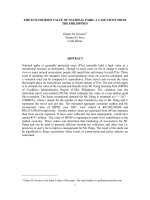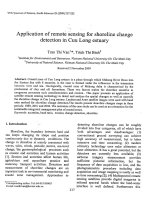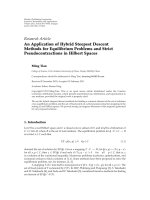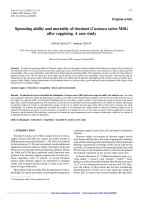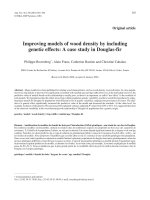An application of GIS and Remote Sensing for Analysis of Agricultural Development-Induced Changes in Land Use: A case study in Lao PDR pdf
Bạn đang xem bản rút gọn của tài liệu. Xem và tải ngay bản đầy đủ của tài liệu tại đây (1.9 MB, 24 trang )
An application of GIS and Remote Sensing for Analysis of
Agricultural Development-Induced Changes in Land Use:
A case study in Lao PDR
By
Boundeth Southavilay1), 2), Teruaki Nanseki 3)
The 30th APAN Meeting
August 2010, in Hanoi, Vietnam
1). Graduate school of Bioresource and Bioenvironmental Science, Kyushu University, Japan.
2).Department of Planning, Ministry of Agriculture and Forestry, Lao PDR.
3). Faculty of Agriculture, Kyushu University, Japan
E-Mails: ;
1
Contents
1.
Introduction
2.
Statement of problems
3.
Objectives
4.
Materials and Methods
5.
Study area
6.
Results and Discussions
7.
Conclusions
2
Introduction
•
In the last decade, in Laos GIS and Remote sensing (RS) has not much used in
countrywide, including agriculture sector did not applied this technique for their
agricultural development and land use planning.
•
A meanwhile, in that times agriculture lands in Laos were transformed from subsistence
farming in uneconomic-sized farms to commercial and market-oriented farms. These
transformed sometimes happens in improperly ways and induced to change in land use
and land covers by despoilment of forest covers and traditional farming system.
•
The problems above due to lack of an appropriate tool in terms of integrated spatial data
on land use/land covers. However, recently GIS and remote sensing has been using in
several types of works in both government and private agencies. As we know, GIS and
remote sensing have an important role in linkage and analysis of such data, in particular
for detection, interpretation, area calculation, monitoring and future estimating. Therefore,
this study applied GIS and remote sensing for analysis the land use pattern changes
3
Statement of Problems
• After 1999, the landscape in the study area has been
changed cause of policy implementation such as rubber
plantation and irrigation system were installed in the area,
and than this place was changed in dynamics way of land
use system
• The forest area was destroyed by increasingly shifting
cultivation and rubber plantation areas
• Lack of an appropriate tool for decision support system in
terms of land use decision
Rubber plantation
Shifting cultivation
4
Objectives
• To illustrate the change detection of land use and land
covers
• To create a tool for decision support system in the
watershed land use planning by created land zoning.
5
Materials and Methods
6
Materials
•
•
•
•
Satellite images:
– Landsat ETM+ (25 January 1999), LIG
format
• Resolution
– 30 m (band 1-5,7)
– 15 m panchromatic
– Landsat ETM+ (12 March 2004), BIL
format
• Resolution
– 25 m (band 1-5,7)
– 15 m panchromatic
GIS data bases with thematic maps (Road
networks, River networks, Village points,
Contour line, DEM and Ground check pointfrom GPS)
Topography map 1:100,000
(Schema F-47-142 and F-47-130)
Software: ArcView3.2a and Idrisi 32
7
Methods
1.
Geometric correction- to georeference maps to a map
coordination system
–
–
2.
Change pixels size- because the pixel sizes of two images
are different (30m and 25m)
–
3.
Image 1999 was registered to local topography maps with 15
ground control points. root-mean-square (RMC) error = 0.45
pixels.
Image 2004 was registered with registered of image 1999
(image to image). RMC= 0.14 pixels.
Change pixel 30m of image 1999 to 25m of image 2004
NDVI compositing utility
– NDVI is useful for identifying of the green leaf from
other objects (water, soil…) It is expressed value -1 to
1 with 0 representing non vegetation
–
NDVI solve the shadow problem
NDVI image
NDVI= (b4-b3)/(b4+b3)
8
Methods (cont.)
•
Images interpretation by Supervised classification
Training area (AOI)
•
Supervised classification
– Maximum likelihood method
The training area from two images 345,
and 2ndvi7 in the1999 and 2004
– classified to 11 classes
•
9
Create zone by overlaid three physical data (Ground data, GIS data and image
classification)
The area is located in the northern Laos,
Lat: 65º07'16" to 67º59'13"
Long: 222º79'96" to 225º56'22".
43 villages
Study area
1250msl
300msl
•
•
Area 696 km2
•
Watershed boundary area = 22 km2
•
Elevation from 300 to 1,235 msl
10
The lowland farms are located between 300 to 450 msl.
Results and Discussions
•
The result of interpretation of two images ETM+1999 and ETM+2004, it provided two
land use maps of 1999 and 2004. In each map was classified into 11 categories of land
use/land cover types
Land covers 1999
Land covers 2004
Intensive of changed areas
11
1999
land use classes
2004
Km2
%
Km2
%
Dark evergreen forest
199.54
28.66
148.7
21.4
Bright evergreen forest
173.94
24.99
134.8
19.4
Disturbed forest/fallow
164.27
23.60
305.1
43.8
Bamboo
22.98
3.30
12.4
1.8
Field crop
32.53
4.67
4.0
0.6
Wet paddy
24.08
3.46
23.6
3.4
0
0
10.5
1.5
22.56
3.24
0
0
Reservoir
0.02
0.00
6.6
0.9
Mekong
6.62
0.95
3.1
0.4
Sandy area
1.70
0.24
4.1
0.6
47.92
6.88
43.2
6.2
696.2
100.00
696.2
Results of Maximum Likelihood
Classification of two images
1999 and 2004
100.0
Irrigation paddy
Bare land/Wet soil
Shrub/other crops
Total
Changes
land use classes
Changed
Dark evergreen forest
Bright evergreen forest
Disturbed forest/fallow
Bamboo
Field crop
Wet paddy
Irrigation paddy
Bare land/Wet soil
Reservoir
Mekong
Sandy area
Shrub/other crops
Km2
Percentage (%)
-50.84
-39.14
140.83
-10.58
-28.53
-0.48
10.5
-22.56
6.6
-3.52
2.4
-4.72
-25.48
-22.50
85.73
-46.04
-87.70
-1.99
-100.00
-53.17
141.18
-9.85
Change rate
(%km2/year)
-5.10
-4.50
17.15
-9.21
-17.54
-0.40
0.00
-20.00
0.00
-10.63
28.24
12
-1.97
Cheng detection
•
•
The change detection is the process of identifying differences in the
state of an object or phenomenon by observing it at different times
(Singh, 1989).
The change detection of land use and land cover of the study area
was analyzed by cross-classification technique– by overlaid of two land use maps
2004
1999
+
=
=
The change detection provides the characteristic changes of each land use type
13
Legend:
DT‐ Disturbed forest/fallow
EF‐ Evergreen forest
FC‐ Field crop
BB‐ Bamboo
BL‐Bare land
WPD‐ Wet paddy
IPD‐ Irrigation paddy
RV‐ Reservoir
14
detection of land use/land cover by crossclassification during 1999 to 2004
No
Land use change 1999-2004
Pixels
Hectares
Km2
%
1
Disturbed > Evergreen Forest
42676
2,667.25
26.67
3.83
2
Evergreen Forest > Disturbed
215062
13,441.38
134.41
19.31
3
Field crop > Disturbed
35353
2,209.56
22.10
3.17
4
Bare land > Disturbed
38975
2,435.94
24.36
3.50
5
Disturbed > Field crop
867
54.19
0.54
0.08
6
Wet paddy > Field crop
932
58.25
0.58
0.08
7
Disturb > Wet paddy
5504
344.00
3.44
0.49
8
Bare land > Wet paddy
7702
481.38
4.81
0.69
9
Disturbed > Irrigation paddy
5883
367.69
3.68
0.53
10
Field crop > Irrigation paddy
476
29.75
0.30
0.04
11
Wet paddy > Irrigation paddy
5398
337.38
3.37
0.48
12
Disturbed > Reservoir
2627
164.19
1.64
0.24
13
Wet paddy > Reservoir
1941
121.31
1.21
0.17
14
Evergreen Forest > Bare land
3297
206.06
2.06
0.30
15
Disturbed > Bare land
20361
1,272.56
12.73
1.83
16
No changes
726786
45,424.13
454.24
During 5 years 3
land use types
were changed to
shifting cultivation:
18,100ha
65.25
Total
1113840
69615
696.15
100.00
15
Land use changed in watershed boundary
May,1999
March, 2004
Dense forest
Open forest
Shifting cultivation
Bamboo
Field crop
Wet paddy
Irrigated paddy field
Reservoir
Shrub land/other
Dense forest
Open forest
Shifting cultivation
Bamboo
Field crop
Wet paddy
Bare land
Shrub land/other
Hectares
14000
Irrigated paddy (dry season)
12000
Area (ha)
1999
Land use types
Land use/land cover changes from 1999 to 2004
Reservoir
10000
Bare land/wet soil
8000
Field crop
6000
2004
%
Hectares
%
202.44
0.92
0.00
0.00
467.82
2.14
551.38
2.51
0.00
0.00
830.69
3.79
46.44
0.21
831.81
3.79
356.69
1.63
Wet paddy (rainy season)
2000
0.00
Bamboo
4000
0.00
952.56
4.34
740.25
3.37
Shrub/other crops
0
Year
2
Dense forest
Mix-deciduous forest
Bamboo
Shifting cultivation
Field crop
Wet paddy
Irrigation paddy
Bare land/wet soil
Reservoir
1
Shrub/other crops
1596.69
7.28
1524.56
6.95
Mixed-deciduous forest
5286.25
24.10
2827.38
12.8
Dense forest
5813.31
26.50
4112.13
18.7
Shifting cultivation
6061.94
27.64
11657.81
53.1
21935.50
100.0
21935.5
100.0
Total areas
16
Zonation
Ground information
Combine land use
type/land holding
in the villages
Population and
village location
GIS data
Raster maps: Slope,
DEM
Vector maps: river,
boundary
Watershed Zonation
map
Remote Sensing
Composite/NDVI
maps
Land use/land
cover
Decision Support
Land use planning
• The zone was created by overlaid of three physical information (Ground data,
GIS data and satellite imagery data)
• The zonation can be regarded as a tool for sustainable agricultural
development in the watershed area.
17
Suggestion zones for sustainable of watershed management
Buffer zone
Conservation zone
This zone is designed to link
between development and
conversation zones. Land use
option: field crop, fruit tree and
commercial tree
Area covered 25%
The main purpose of this zone is to
protect forest covers because this
zone included headwater, district
protected area and high forest cover
and biodiversity.
Area covered 43%
Development zone
The development zone includes
integrated farming systems and more
commonly associated with upland
areas. Located along the river banks
and foothills.
Land use options: paddy, fish ponds,
rice/fish, terraced paddy, grazing,
field crops, fruit trees, commercial
tree.
Area covered: 32%
18
The optional land use for sustainable agricultural development in the
watershed area
x=Restricted potential, xx=Medium potential, xxx=High potential, o=not considered appropriate.
19
The existing of land cover in the study area
Development zone
Conservation zone
Conservation zone
Buffer zone
Conservation zone
Buffer zone
Development zone
21
Conclusions
For 1st objective
1.The total areas of the fallow forest were doubly increased from 16,427
ha in 1999 to 30,510 ha in 2004. This land use type was high potential to
be mixed by different types of land use such as disturbed forest/fallow
forest/shifting cultivation/rubber plantation.
2.Based on our results suggest that after irrigation dam was constructed,
several types of land use areas were changed (decreased/increased) and
fragmented (field crop, evergreen forest, fallow forest) as a result of both
farmers who lost their lands and turned to clear-cut forest areas for upland
rice cultivation, and private investment on commercial tree (rubber
plantation).
22
Conclusions (cont.)
For 2nd objective
1.The tool for decision support system in sustainable of agricultural
development in this study is the land use zoning was created by GIS
and remote sensing technique. By created 3 main land use zones.
1. Conservation zone
2. Buffer zone
3. Development (Agricultural) zone
2.These zones can be the most important tools for agricultural
development planning because it provided integrated information on
social and physical aspects of the study area.
23
Thank you very much for your
kind attention
24





